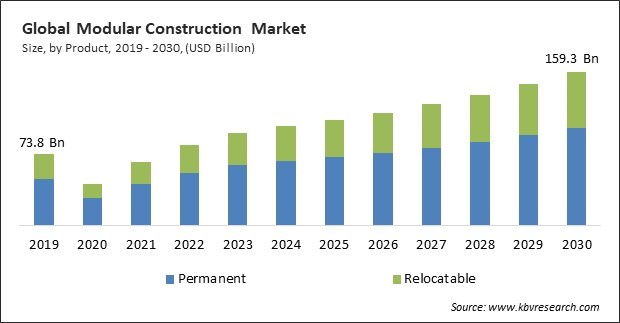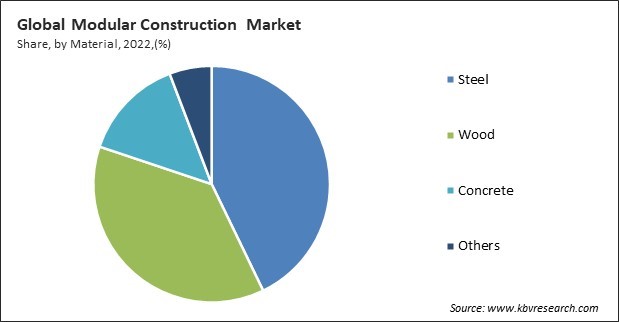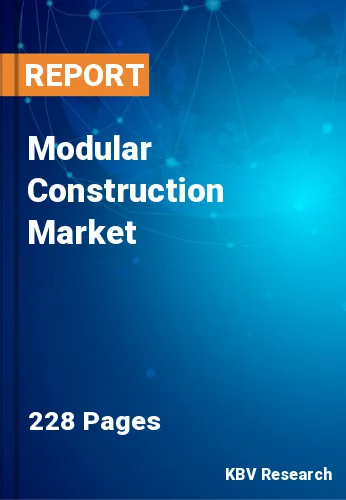The Global Modular Construction Market size is expected to reach $159.3 billion by 2030, rising at a market growth of 7.4% CAGR during the forecast period.
The rapid construction timelines associated with modular construction make it an attractive option for residential projects. Consequently, the residential segment captured $44,277.2 million revenue in the market in 2022. The demand for affordable housing has been a significant driver for the growth of modular construction in the residential sector. Modular construction offers cost-effective solutions, enabling the efficient production of housing units at scale. Homebuyers and developers benefit from quicker project delivery, allowing for faster occupancy and reduced construction-related disruptions. As a result, there will be an increased demand in the segment. Some of the factors impacting the market are faster speed of modular construction, higher flexibility in design and application and high transportation costs associated with modular construction.

Tasks like site preparation, foundation work, and on-site construction occur sequentially in traditional construction. In contrast, modular construction enables these tasks to happen simultaneously. While modules are being fabricated off-site in a factory-controlled environment, on-site work such as foundation preparation, utility installation, and other site-related activities can progress concurrently. Because of the parallel processing of tasks, modular construction projects often have significantly reduced overall construction timelines compared to traditional methods. Additionally, Modular construction allows for diverse design possibilities. Modular units can be customized to meet specific architectural and design requirements. This flexibility enables various building types and styles, from residential homes to commercial structures. Modular units are designed to be easily reconfigured or expanded. As needs change, additional modules can be added, or existing ones can be rearranged to accommodate new requirements. This scalability is beneficial in scenarios where the size of a facility needs to be adjusted in response to changes in business operations or occupancy requirements. These factors will help in the expansion of the market.
However, the geographical separation between the manufacturing facility and the construction site is pivotal in determining transportation costs. Long-distance transportation incurs higher freight expenses, encompassing the logistics of moving large and often heavy modular units to their destination. The need for specialized transportation methods and equipment further contributes to the overall cost burden. Transporting modular units over extended distances introduces logistical complexities. Coordinating the movement of multiple modules, ensuring timely arrivals, and navigating potential challenges such as traffic, road conditions, and regulatory requirements demand meticulous planning. The cumulative effect of transportation costs raises questions about modular construction's economic viability for projects far from manufacturing facilities. Stakeholders, including developers and investors, must carefully assess the overall project budget, factoring in transportation expenses, to determine the feasibility and cost-effectiveness of modular construction in specific geographical contexts. These factors can limit the growth of the market in the future.
Based on product, the market is bifurcated into relocatable and permanent. The permanent segment held the largest revenue share in the market in 2022. Ongoing technological advancements, including the use of Building Information Modeling (BIM) and sophisticated design software, have contributed to the growth of permanent modular construction. These technologies facilitate precise planning, design, and execution, ensuring the quality and longevity of permanent structures. Owing to these factors, there will be increased growth in the segment.
On the basis of material, the market is divided into wood, steel, concrete, and others. In 2022, the wood segment witnessed a substantial revenue share in the market. Wood is considered a sustainable and renewable building material. Engineered wood products, such as cross-laminated timber (CLT) and glue-laminated timber (glulam), are increasingly used in modular construction. This is an effort to reduce the carbon footprint of buildings in the construction industry, which is motivated by rising environmental concerns. These materials offer the structural integrity required for building stability while being relatively lightweight, which aligns well with the modular construction approach of prefabrication and ease of transportation. Therefore, the segment will expand rapidly in the upcoming years.

Based on application, the market is divided into residential, commercial, industrial, healthcare, and educational. The healthcare segment procured a substantial revenue share in the market in 2022. Healthcare facilities often have specific and evolving requirements. The considerable adaptability of modular construction in terms of design and configuration permits the adaptation of spaces to suit the specific requirements of various healthcare environments. This adaptability is particularly valuable in the healthcare sector, where spaces may need to be reconfigured or expanded to accommodate changing medical practices or technology. Therefore, the segment will witness rapid growth in the coming years.
| Report Attribute | Details |
|---|---|
| Market size value in 2022 | USD 83.6 Billion |
| Market size forecast in 2030 | USD 159.3 Billion |
| Base Year | 2022 |
| Historical Period | 2019 to 2021 |
| Forecast Period | 2023 to 2030 |
| Revenue Growth Rate | CAGR of 7.4% from 2023 to 2030 |
| Number of Pages | 228 |
| Number of Table | 370 |
| Report coverage | Market Trends, Revenue Estimation and Forecast, Segmentation Analysis, Regional and Country Breakdown, Porter’s 5 Forces Analysis, Company Profiling, Companies Strategic Developments, SWOT Analysis, Winning Imperatives |
| Segments covered | Material, Product, Application, Region |
| Country scope |
|
| Companies Included | Sekisui House, Ltd., LAING O'ROURKE, Red Sea International Company, Skanska Group AB, Premier Modular Limited, KLEUSBERG GmbH & Co. KG, Wernick Group, Lendlease Corporation Limited, Hickory Group and Guerdon, LLC. |
| Growth Drivers |
|
| Restraints |
|
Region-wise, the market is analysed across North America, Europe, Asia Pacific, and LAMEA.In 2022, the Asia Pacific segment acquired a considerable revenue share in the market. The Asia Pacific region has been undergoing rapid urbanization, with a growing need for efficient and rapid construction solutions. Modular construction provides a viable option to meet the demand for housing, commercial spaces, and infrastructure in urban areas, where traditional construction methods may face logistical challenges. The high population density in many Asia Pacific countries, particularly urban centres, has increased demand for affordable and scalable housing solutions. Modular construction offers a faster, more cost-effective way to address housing shortages and accommodate the growing population. These aspects will help expand the Asia Pacific segment in the future.
Free Valuable Insights: Global Modular Construction Market size to reach USD 159.3 Billion by 2030
The market research report covers the analysis of key stake holders of the market. Key companies profiled in the report include Sekisui House, Ltd., LAING O'ROURKE, Red Sea International Company, Skanska Group AB, Premier Modular Limited, KLEUSBERG GmbH & Co. KG, Wernick Group, Lendlease Corporation Limited, Hickory Group and Guerdon, LLC.
By Product
By Material
By Application
By Geography
This Market size is expected to reach $159.3 billion by 2030.
Faster speed of modular constructionare driving the Market in coming years, however, High transportation costs associated with modular construction restraints the growth of the Market.
Sekisui House, Ltd., LAING O'ROURKE, Red Sea International Company, Skanska Group AB, Premier Modular Limited, KLEUSBERG GmbH & Co. KG, Wernick Group, Lendlease Corporation Limited, Hickory Group and Guerdon, LLC.
The expected CAGR of this Market is 7.4% from 2023 to 2030.
The Steel segment is leading the Market by Material in 2022;there by, achieving a market value of $65.1 billion by 2030.
The Europe region dominated the Market by Region in 2022 and would continue to be a dominant market till 2030;there by, achieving a market value of $61.3 billion by 2030.
Our team of dedicated experts can provide you with attractive expansion opportunities for your business.

